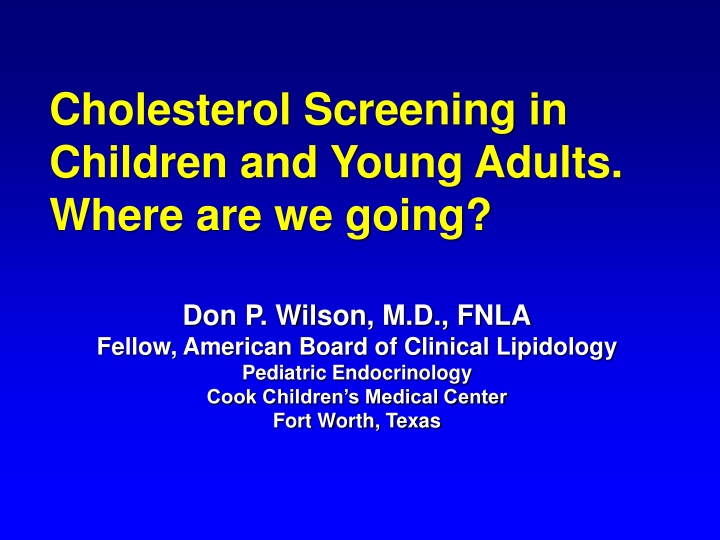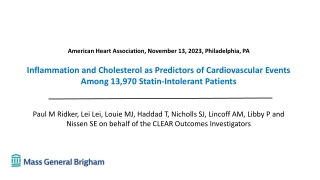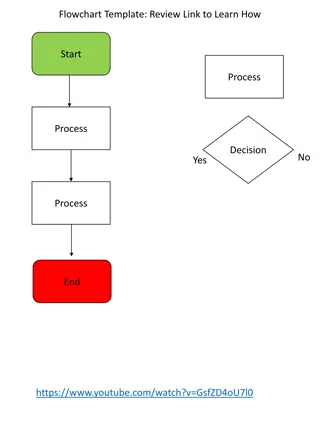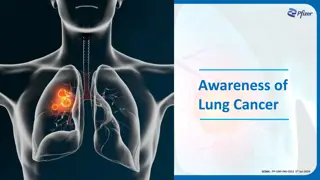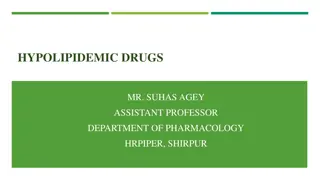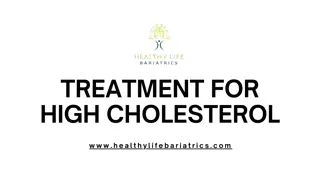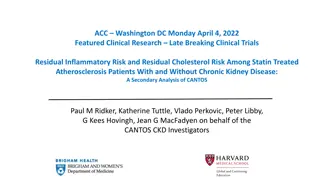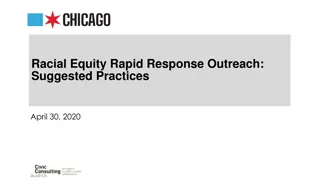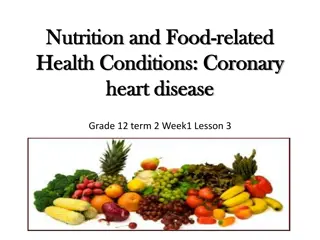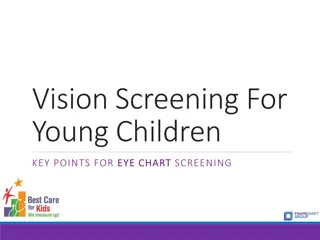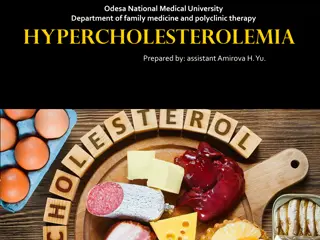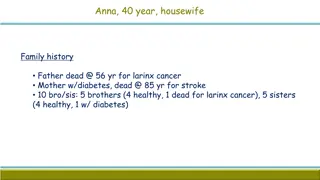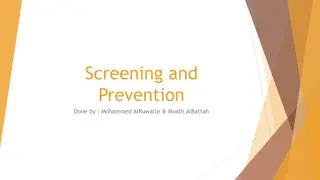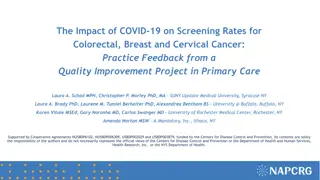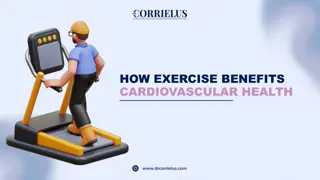Cholesterol Screening in Children and Young Adults: Where Are We Going?
Cholesterol screening in children and young adults is crucial for early detection of lipid disorders, guiding interventions, and reducing cardiovascular risk. Understanding the rationale, principles, and global perspectives on screening contributes to optimizing healthcare strategies.
Download Presentation

Please find below an Image/Link to download the presentation.
The content on the website is provided AS IS for your information and personal use only. It may not be sold, licensed, or shared on other websites without obtaining consent from the author.If you encounter any issues during the download, it is possible that the publisher has removed the file from their server.
You are allowed to download the files provided on this website for personal or commercial use, subject to the condition that they are used lawfully. All files are the property of their respective owners.
The content on the website is provided AS IS for your information and personal use only. It may not be sold, licensed, or shared on other websites without obtaining consent from the author.
E N D
Presentation Transcript
Cholesterol Screening in Children and Young Adults. Where are we going? Don P. Wilson, M.D., FNLA Fellow, American Board of Clinical Lipidology Pediatric Endocrinology Cook Children s Medical Center Fort Worth, Texas
Disclosures Osler Institute - Speaker Insulet - Speaker Aegerion Pharmaceuticals - Advisory Board Alexion Pharmaceuticals - Advisory Board Merck Sharp & Dohme - Research Funding Novo Nordisk Inc.- Research Funding
Rationale for Cholesterol Screening 1. Abnormal lipid values are highly prevalent. 2. Well documented relationship between total and LDL-C levels and CHD risk. 3. Treatment decreases the risk of CVD events. 4. Early knowledge of a lipid disorder creates the best opportunity for early intervention.
Principles of Screening Congenital Hypothyroidism Affects 1:4000 newborns Increased Risk Developmental Delay Mental Retardation Shared Decision Physician Parent Serious Morbidity and Mortality Willing to Treat Treatment Thyroid Hormone 10-15 mcg/kg/d Reliable monitoring Testing - TSH Reliable Specific Effective Treatment Reliable Testing
Newborn Screening Mandatory Op-Out Only State Screening Centralized Testing and Case Management Notification of Abnormal Test Results Regulation and Advocacy Professional and Public Education Primary Care Regional Consultant Annual Follow-up Statistics and Reporting
Question Which of the following is the key goal of cholesterol screening? a. Familial hypercholesterolemia. b. All genetic disorders associated with increased atherogenic cholesterol. c. All acquired conditions associated with increased atherogenic cholesterol. d. a and b. e. b and c.
Cholesterol Screening World Health Organization 9 Key Principles of Screening Wilson JMG, Jungner G. PRINCIPLES AND PRACTICE OF SCREENING FOR DISEASE. In: Organization WH, editor. Geneva: World Health Organization; 1968.
#1 An important health problem. 1. CVD is the leading cause of morbidity and mortality worldwide. 2. In the U.S. more than 600,000 ( 1 in 4) die of heart disease each year. 3. Of those with heart disease, coronary heart disease is the most common, killing > 370,000 people annually. 4. Abnormalities in lipoprotein metabolism represent approximately 50% of the population attributable risk of CVD. CDC, 2015; Mozaffarian D, 2015
#1 An important health problem. Cholesterol screening has the potential to identify a wide variety of primary and secondary conditions, including: 1. Genetic mutations in lipid and lipoprotein metabolism. 2. Acquired dyslipidemia, especially related to unhealthy lifestyles, obesity, medications, etc. It is, therefore, critical to identify the primary goal of cholesterol screening.
#1 An important health problem. Many believe familial hypercholesterolemia (FH) should be the primary goal of cholesterol screening. Why FH? 1. Mortality rates from CHD in FH: a. 100x greater in those age 20-39 b. 4x greater in those age 40-59 2. Children with untreated HeFH have a dramatic increase in risk of premature CHD after 20 years of age. Youssef AA, Srinivasan SR, Elkasabany A, Chen W, Berenson GS. Trends of lipoprotein variables from childhood to adulthood in offspring of parents with coronary heart disease: the Bogalusa Heart Study. Metabolism. 2001; 50:1441 6.
Question In the U.S. how frequently, on average, is a child born with familial hypercholesterolemia (FH)? a. Every 1 minute b. Every 5 minutes c. Every 10 minutes d. Every 60 minutes Familial hypercholesterolemia 1:250
#1 An important health problem. 2. Current diagnosis and treatment of FH is: a. Very inadequate (<1% indentified) b. Often delayed c. Despite effective interventions, late treatment often results in significant residual risk and poor outcomes.
#1 An important health problem. Cholesterol screening What are the cons? 1. Some argue that screening young adults w/out other risk factors for CVD should be delayed until > 40 yrs of age, since absolute risk reduction in CVD events will be small. 2. There are no studies showing a positive effect of screening in young adults (e.g., ages 18-35)
#1 An important health problem. Cholesterol screening What are the cons? 1. Screening the entire population: a. Can be costly b. May result in the use of unnecessary medication in lower-risk individuals. Therefore for some, the benefits of screening individuals < 40 yrs of age is uncertain.
#2 Accepted treatment for patients with recognized disease. A variety of effective lipid lowering medications are available for the treatment of FH: 1. Children 6 yrs of age and older: rosuvastatin* 2. Children 8 yrs of age and older: pravastatin 3. Children 10 yrs of age and older: a. All statins (except pitavastatin) b. Ezetimibe c. Colesevelam *Europe
#2 Accepted treatment for patients with recognized disease. 2011 NHLBI s Expert Panel What was said What was heard All children should undergo lipid screening and interventions for genetic and acquired risk factors and conditions. All children who are obese should undergo lipid screening and treated with statins.
#3 Recognizable latent or early symptomatic stage. 1. Children and young adults with FH are rarely symptomatic. 2. While CVD typically manifests in adulthood, the process begins in childhood. 3. Identifying children is critical to reducing the burden of disease in adulthood. 4. Some, but not all, guidelines underscore the value of noninvasive imaging of atherosclerosis (e.g. cIMT) in assessing and managing asymptomatic FH subjects.
#4 Suitable test or examination. 1. The majority of FH children and young adults have no physical signs/symptoms of hypercholesterolemia. 2. Blood testing a. Cholesterol - quick, easy, inexpensive and generally reliable. b. Genetic Testing - costs are high, but improving.
#4 Suitable test or examination. Question: True or False? The US Preventative Task Force recommended against cholesterol screening in children and adolescents? The USPTF concludes that the current evidence is insufficient to assess the balance of benefits and harms of screening for lipid disorders in children and adolescents 20 years or younger. Therefore, the USPTF statement is neither for or against. Screening for Lipid Disorders in Children and Adolescents: US Preventive Services Task Force Recommendation Statement. JAMA. 2016; 316(6):625-33.
#4 Suitable test or examination. Summary of USPTF Screening Recommendations Recommendation Recommended Criteria If at increased risk for CHD Men 20-35 35 and Older Strongly recommended None Women 20-45 Recommendation Recommended Criteria If at increased risk for CHD 45 and Older Strongly recommended If at increased risk for CHD Final Recommendation Statement: Lipid Disorders in Adults (Cholesterol, Dyslipidemia): Screening. U.S. Preventive Services Task Force. December 2014.
#4 Suitable test or examination. 1. USPTF preferred screening tests: TC and HDL-C on non-fasting or fasting samples. 2. Measuring TC alone is acceptable. 3. Optimal interval for screening is uncertain; reasonable options include every 5 years, or sooner if clinically indicated. 4. An age to stop screening has not been established. Screening for Lipid Disorders in Children and Adolescents: US Preventive Services Task Force Recommendation Statement. JAMA. 2016; 316(6):625-33.
What age to screen? Cholesterol Screening Age Type Criteria > 2 yrs of age Selective 1 or both biologic parents known to have hypercholesterolemia or are receiving LLM; or Family history of premature CVD (i.e. men < 55 yrs; women < 65 yrs); or Whose family history is unknown (e.g. children who were adopted). > 10 yrs of age* Universal Regardless of general health or the presence/absence of CVD risk factors. If normal, repeat every 5 yrs. *Selective screening if clinically indicated. LLM = lipid-lowering medications; CVD = cardiovascular disease National Lipid Association Annual Summary of Clinical Lipidology 2017. J of Clinical Lipidology (2016) , S1-S50
European Atherosclerosis Society Children suspected of FH should be screened from the age of 5 years. Cascade screening of families is recommended using a combined phenotypic and genotypic strategy. Universal screening of children may be another option, depending on practical and cost considerations.
What age to screen? The literature suggests that the optimal age range for screening is between 1 - 9 years, as determined by optimal discrimination using cholesterol measurement between children with and without FH. Wald David S, Bestwick Jonathan P, Wald Nicholas J. Child-parent screening for familial hypercholesterolaemia: screening strategy based on a meta-analysis BMJ 2007; 335 :599
Detection rate plotted against the false positive rate for total and LDL-C measured at different ages. Detection Rate (%) This illustrates the maximum discrimination at 1-9 yrs and shows that there is little additional increase in the detection rate as the false positive rate increases above 1%. Detection Rate (%) At a false positive rate of 0.1%, the detection rate in the 1-9 yr age group was: Total Cholesterol 88% LDL Cholesterol 85% Wald David S, Bestwick Jonathan P, Wald Nicholas J. Child-parent screening for familial hypercholesterolaemia: screening strategy based on a meta-analysis BMJ 2007; 335 :599
#5 Test should be acceptable to the population. Cholesterol Screening Patient/Family Concerns 1. Testing methods a. Finger prick vs. venipuncture b. Fasting vs. non-fasting c. POC vs. Lab 2. Psychological issues (e.g. fatalism ) 3. Practical issues a. Cost of testing/insurance coverage b. Increased life insurance premiums
A systematic review and meta-analysis on screening lipid disorders in the pediatric age group. Aim: Assess the effectiveness of lipid screening in youth (2 to 20 yr) according to the existence of positive family history of CVD risk factors. Study cohort: 37,304 assessed for dyslipidemia. Results: Sensitivity = 42.65% / Specificity = 59% Predictive value = 20.7% Kelishadi R, Haghdoost AA, Moosazadeh M, Keikha M, Aliramezany M. A systematic review and meta- analysis on screening lipid disorders in the pediatric age group. J Res Med Sci 2015;20:1191-9.
Family History Reliance on family history alone as a basis for lipid screening fails to identify as many as 30- 60% of children and adolescents with elevated levels of cholesterol. Dennison 1989, Griffin 1989, Freedman 1992
Natural history of the condition #6 should be adequately understood. Ischemic Heart Disease Cerebrovascular Disease Peripheral Vascular Disease Lesion: Initiation Progression + Stable No Symptoms Symptoms + Symptoms Reversible Non - Reversible + Reversible Years
#7 Agreed policy on whom to treat. Guidelines and Recommendations are available from a variety of professional organizations and societies: 1. National lipid Association 2. ACC/AHA 3. NHLBI/NIH 4. USPSTF 5. American Academy Pediatrics 6. American Academy of Clinical Endocrinologist 7. American Diabetes Association 8. and others, including European guidelines
#7 Agreed policy on whom to treat. Application of pediatric vs adult guidelines for lipid levels, which consider additional CVD risk factors beyond age and LDL-C, might result in statin treatment for more than 400,000 additional adolescents and young adults JAMA Pediatr. 2015 Jun;169(6):569-74. doi: 10.1001/jamapediatrics.2015.0168. Application of Pediatric and Adult Guidelines for Treatment of Lipid Levels Among US Adolescents Transitioning to Young Adulthood. Gooding HC1, et. al.
#8 Cost of case-finding should be economically balanced. Cost effectiveness of screening for FH is dependent upon 3 factors: 1. Cost effectiveness of treatment, once FH is identified. 2. The underlying prevalence of FH among the screened population. 3. The accuracy (validity) of the screening test. A systematic review of economic evaluations of the detection and treatment of familial hypercholesterolemia. Ademi, et al. International Journal of Cardiology 167 (2013) 2391 2396.
#8 Cost of case-finding should be economically balanced. For the vast majority of children with FH, there is 1 affected parent. Child-parent screening strategies have the potential to prevent medical consequences of FH in 2 generation simultaneously. Wald David S, Bestwick Jonathan P, Wald Nicholas J. Child-parent screening for familial hypercholesterolaemia: screening strategy based on a meta-analysis BMJ 2007; 335 :599
#8 Cost of case-finding should be economically balanced. Conclusion: 1. Cascade screening is more cost effective than any other screening strategy currently available. 2. However, cost of genetic testing has dramatically decreased in recent years, and may become more acceptable and feasible in the future. Ademi, et al. International Journal of Cardiology 167 (2013) 2391 2396. Marks D, Wonderling D, et al. BMJ. 2002;324(7349):1303. National Institute for Health and Clinical Excellence (NICE). Familial Hypercholesterolaemia Costing Report: Implementing NICE guidance. 2009. pp.1 42. https://www.nice.org.uk/guidance/cg71/resources/familialhypercholesterolaem ia-costing-report2.
Question On average, how long does it take for evidence from RCTs to be incorporated into clinical practice? a. 3 years b. 9 years c. 17 years d. >20 years
Why Dont Physicians Follow Clinical Practice Guidelines? Physician adherence is critical in improving outcomes. Historically, guidelines have had limited effect on changing physician behavior. M. Cabana, et al. JAMA. 1999;282:1458-1465
Clinical Practice Guidelines - Barriers that undermine the process. 1. Physician knowledge: Lack of awareness and familiarity. 2. Physician attitudes: Lack of agreement, outcome expectancy, and the inertia of previous practices. M. Cabana, et al. JAMA. 1999;282:1458-1465
Clinical Practice Guidelines - Barriers that undermine the process. 3. External barriers: a. Guideline related - not easy to use, not convenient, confusing. b. Patient related - lack of acceptance, not covered by insurance. c. Environmental - lack of time, insufficient staff, lack of consultative support. M. Cabana, et al. JAMA. 1999;282:1458-1465
#9 Case-finding should be a continuing process. B.G. Nordestgaard et al. European Heart Journal. doi:10.1093/eurheartj/eht273
Principles of Screening Familial hypercholesterolemia Affects 1:250 FH Shared Decision Physician Parent Serious Morbidity and Mortality Willing to Treat Premature CVD MI CVA Death LLMs Statins Ezetimibe BAS New agents* Tests - Cholesterol + Genetic Testing Reliable Accurate Accessible Inexpensive Effective Treatment Reliable Testing * Not FDA approved <18 yr
Cholesterol Screening Guidelines 1NHLBI NLA ACC/AHA Who to Screen? Selective Screening Yes Yes Yes Universal Screening Yes Yes Yes Age at First Screening? Selective Screening >2 yrs >20 yrs >20 yrs Universally Screening 9-11 yrs >20 yrs >20 yrs 2Repeat Screening 17-20 yrs 3Every 5 yrs --- What to Order? Fasting or non-fasting lipid panel Yes Yes Yes Calculate non HDL-C Yes Yes Yes Risk Factors Assessment? Yes Yes Yes ASCVD Risk 10 Year Estimate? 4N/A 4Yes 4Yes 1 These recommendations have been endorsed by the American Academy Pediatrics, National lipid Association and American Heart Association. 2 If initial levels of artherogenic cholesterol (non-HDL-C and LDL-C) are in the desirable range. 3 Or sooner based upon clinical judgement. 4 Risk calculators are not applicable to children and adolescents, and may either over- or under estimate risk in those < 40 years of age. 5Every 4-6 yrs NLA = National Lipid Association. J Clin Lipidol. 2014 Sep-Oct; 8 (5):473-88. Part 2. J Clin Lipidol. 2015 Nov-Dec; 9 (6 Suppl):S1-122. ACC/AHA = American College of Cardiology/American Heart Association. Circulation. 2014;129 [suppl 2]:S1-S45). NHLBI = National Heart, Lung, and Blood Institute: Summary Report. Pediatrics 2011; 128(Suppl 5):S1-S44.
Final thoughts There is no generally accepted screening program for children, adolescents, and young adults. Universal screening, started at age 10 and continued every 5 years thereafter, may help simplify the process for busy clinicians. Wiegman A, Gidding SS, et al. Familial hypercholesterolaemia in children and adolescents: gaining decades of life by optimizing detection and treatment. Eur Heart J. 2015;36(36):2425 37.
Final thoughts Many feel FH should be the primary goal of cholesterol screening. Early recognition of a child or young adult with FH, coupled with therapy from a young age, will impede, if not arrest, the onset of atherosclerosis. Wiegman A, Gidding SS, et al. Familial hypercholesterolaemia in children and adolescents: gaining decades of life by optimizing detection and treatment. Eur Heart J. 2015;36(36):2425 37.
Final thoughts Statin therapy alone could potentially avert 96-98% of FH-related CHD deaths in individuals < 40 years of age. Austin MA, Zimmern RL, Humphries SE. High population attributable fraction for coronary heart disease mortality among relatives in monogenic familial hypercholesterolemia. Genet Med. 2002;4(4):275 8.
Final thoughts Identification of a child with FH combined with effective screening of 1st and 2nd degree relatives (i.e. reverse cascade screening): Combines the benefits of universal + cascade screening. Has the potential, within 1 generation, of detecting all cases of FH. Morris JK, Wald DS, Wald NJ. The evaluation of cascade testing for familial hypercholesterolemia. Am J Med Genet A. 2012;158(1):78 84.
Time Course of Human Atherogenesis Years Events Ischemic Heart Disease Cerebrovascular Disease Peripheral Vascular Disease Lesion: Initiation Progression + Stable No Symptoms Symptoms + Symptoms Reversible Non - Reversible + Reversible Intervention
Time Course of Human Atherogenesis Years No Events Early Detection/ Early Intervention Lifelong Heart Healthy Living Lesion: prevention No Symptoms Reversible Intervention
Cholesterol Screening in Children and Young Adults. Where are we going? Don P. Wilson, M.D., FNLA Fellow, American Board of Clinical Lipidology Pediatric Endocrinology Cook Children s Medical Center Fort Worth, Texas
